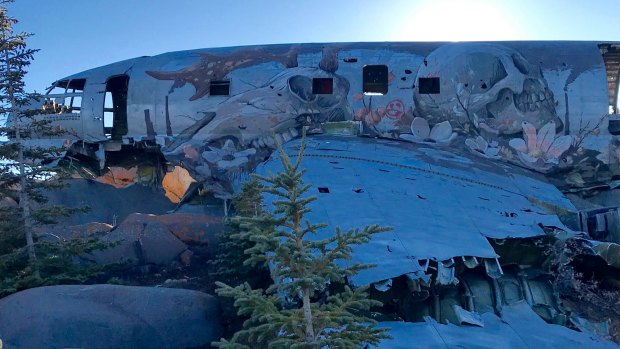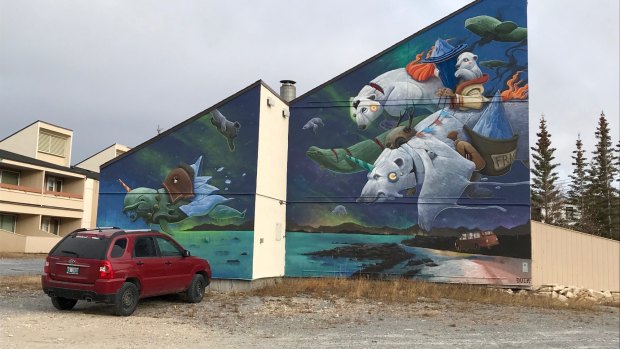This was published 5 years ago
SeaWalls: Artists for Oceans, Churchill: Canada's famous 'ocean' murals, a major tourist attraction
By Julie Miller

Camp10 by Jason Botkin.Credit: Julie Miller
When a severe blizzard and subsequent floods destroyed the railway line leading to the northern Manitoba town of Churchill in May 2017, the impact sent the small community into a spiral.
Not only was it largely cut off from the rest of Canada (there's no road to Churchill and flights, while regular, are prohibitively expensive), the crisis came on the back of the closure of the town's deep-water Arctic port, resulting in the loss of 80 jobs – a 10th of the town's population.
But hope comes in many forms and in Churchill it arrived in the guise of an art festival. In June 2017, a mural project called SeaWalls Churchill not only transformed the sub-Arctic tundra landscape, it also highlighted the town's importance as an environmental touchstone and reminded the devastated community of its worth.

Emergency Transmission by Pat Perry, painted on the side of the plane wreck Miss Piggy.Credit: Julie Miller
SeaWalls: Artists for Oceans is a public art program that has created nearly 300 murals in 12 countries around the world, bringing the message of ocean conservation to the streets. As the "polar bear capital" of the world, and also a crucial breeding ground for beluga whales, Churchill was a natural fit for the project.
But what started as an educational tool to inspire the protection of the oceans soon became a more powerful instrument of hope, with the 18 international artists and a team of volunteers themselves having to overcome the challenges of the town's sudden isolation to fulfil their passion project.
At the helm of Churchill's event was Canadian artist and polar bear enthusiast Kal Barteski. "When I started planning the festival, a rail closure didn't occur to me," Barteski says. "But it happened. Everything fell apart – just affording food and getting supplies became a big deal and a daily struggle for the town.

The Last Winter by DULKCredit: Julie Miller
"We almost called off the festival, but we decided to show up and do what we could with what we could find and borrow. As artists, we can't fix rail lines or political problems, but we can make art, and what is art if it isn't hope?"
The results continue to resonate with the murals now a major tourist attraction. Visitors come to see the 19 paintings that span 30 kilometres along Hudson Bay's foreshore and tell a story that highlights the crucial issues that pertain to this northern region.
The intrinsic tension that exists in Churchill between humans and its biggest attraction – polar bears – is a recurring theme, along with climate change, melting permafrost, unemployment and the ancestral legacy of First Nations people.
Many works decorate abandoned or aesthetically-dubious structures, from military ruins to bunkers on an old rocket range. Even the infamous "Miss Piggy" plane wreck has been adorned, with the artist, Pat Perry commenting on the decline of Churchill's economy with a stark composition using skull imagery.
Arguably the most notable mural is Kal Barteski's rendering of a sleeping polar bear, painted on the most controversial structure in Churchill – the polar bear holding facility. This is where bears that habitually wander too close to town, making a "nuisance" of themselves and threatening human safety are brought to. They are secured here until the sea ice forms and they can be safely shooed away from human habitation.
Barteski's image, which cleverly utilises the rounded shapes of the corrugated iron building, highlights the issues that have led to the need for this wildlife management system in Churchill and examines the beauty of the world's largest land predator, "sleeping peacefully as the world operates around her".
Meanwhile, on the side of the town's drive-through recycling centre – an innovation to discourage bears from rummaging through household garbage – artist Li-Hill has created two scenes: a flurry of polar bears and eskimo dogs on one half, and armed conservation officers on the other, with the images radiating outward from the dividing line.
"Instead of man versus nature, here it is two sides of the same coin," Li-Hill says in his mission statement. "Both humans and endangered species are in a state of fight or flight. A heightened sense of emergency due to climate change and the long list of global issues places everything in a precarious position.
"In a town such as Churchill, the tensions are local but the story is global."
TRIP NOTES
The writer was a guest of Manitoba Tourism and the Churchill Northern Studies Centre.
MORE
FLY
Air Canada flies from Sydney to Vancouver daily, and four flights weekly from Melbourne, with connections to Winnipeg. See aircanada.com.au From Winnipeg, Calm Air flys to Churchill. See calmair.com
STAY
Churchill Northern Studies Centre offers a variety of learning vacations that cost from $CA1425 a person (quadruple occupancy) including meals, tours and visits to the mural sites. See churchillscience.ca
Sign up for the Traveller Deals newsletter
Get exclusive travel deals delivered straight to your inbox. Sign up now.